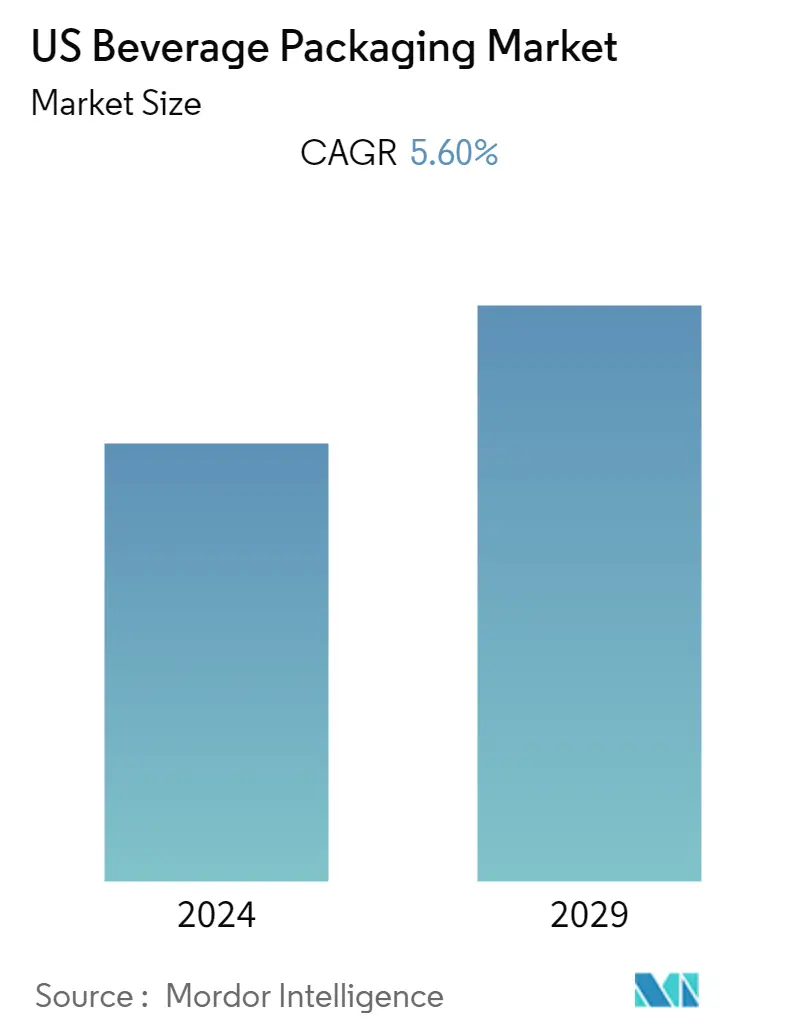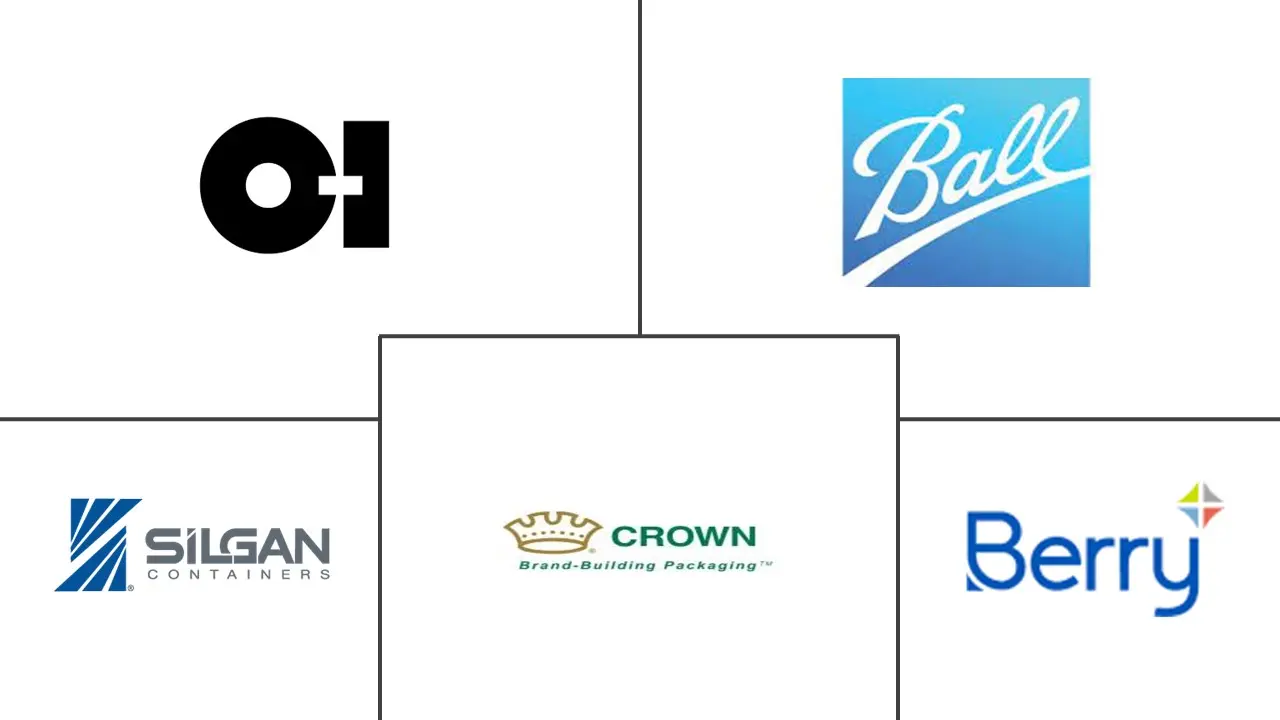Market Size of US Beverage Packaging Industry

| Study Period | 2019 - 2029 |
| Base Year For Estimation | 2023 |
| Forecast Data Period | 2024 - 2029 |
| Historical Data Period | 2019 - 2022 |
| CAGR | 5.60 % |
| Market Concentration | Medium |
Major Players
*Disclaimer: Major Players sorted in no particular order |
US Beverage Packaging Market Analysis
Packaging, as a critical factor, plays an essential role in the widespread consumption of beverages. The US beverage packaging market is estimated to grow at a CAGR of about 5.6% over the forecast period 2021 - 2026. Different beverages being packaged in varied materials and sizes reflect upon the sheer size of the market. Also, being a consumer-end market, the demand for the same has been rising significantly. Major drivers for the same have been growing disposable income, urbanization, and changing lifestyles.
- The growing demand for carbonated drinks, energy drinks, and juices, among others, is indicative of rising PET bottles and metal cans as preferred materials for the same. Glass, on the other hand, with its recyclable properties, has been challenged by increased costs of production and recycling. The preference for the same has been growing recently concerning sustainability trends across beverage packaging.
- Moreover, as plastic has been a long-standing and preferred packaging option by global beverage manufacturers, due to the reduced manufacturing, durability, and logistics costs, the transition towards sustainable packaging has driven these packaging manufacturers and bottling companies to pledge and commit usage of newer materials for the same.
- The American Beverage Association, amongst multiple soft drink producers in the region, announced a USD 100 million joint investment to drive PET bottle recycling in the United States and reduce the industry's use of virgin plastic. Similar trends across multiple regions and countries have been suggestive of a landscape influencing bottlers and packaging manufacturers to pivot product development strategies.
- For instance, as of February 2020, Ball Corporation is expected to expand the United States Metal Can production by 2021. Its specialty beverage can would commence operations in Arizona and the northeastern US, in line with the company's previous commitment to add at least 8 billion units of capacity by the end of 2021.
- Due to COVID-19 impact on the recycling front, multiple waste companies have been observed to have stopped or reduced recycling and collection processes. In the United States, Waste Management suspended operations at some of its materials recovery facilities (MRFs).
US Beverage Packaging Industry Segmentation
The United States beverage packaging market studies the market segmentation based on different materials, like paper, plastic, glass, and metal. The market study focuses on various aspects, such as sustainability, production rate in beverage products, supply and demand, and the impact of COVID-19 on the market.
US Beverage Packaging Market Size Summary
The US beverage packaging market is experiencing significant growth, driven by increasing consumer demand and evolving lifestyle trends. As a critical component of beverage consumption, packaging plays a vital role in the market's expansion. The market is characterized by a diverse range of materials and sizes used to package various beverages, including carbonated drinks, energy drinks, and juices. The shift towards sustainable packaging solutions is gaining momentum, with manufacturers and bottling companies exploring new materials to reduce reliance on traditional plastics. This transition is further supported by initiatives such as the American Beverage Association's investment in PET bottle recycling, which aims to decrease the industry's dependence on virgin plastic. The market's landscape is also influenced by the growing preference for metal cans and aluminum packaging, which are highly recyclable and offer environmental benefits over other materials like glass and plastic.
In the alcoholic beverage sector, packaging innovations are being driven by changing consumer preferences and sustainability concerns. The wine industry, for instance, is adapting its packaging formats to appeal to younger consumers and reduce costs, while beer packaging varies significantly across regions due to local regulations and cultural factors. The COVID-19 pandemic has also impacted packaging demand, with increased home consumption leading to a surge in demand for cans and other packaging formats. Key players in the market, such as Owens-Illinois Inc., Ball Corporation, and Crown Holdings Inc., are investing in new manufacturing facilities and technologies to meet the rising demand for sustainable packaging solutions. These developments underscore the market's dynamic nature and the ongoing efforts to balance consumer needs with environmental considerations.
US Beverage Packaging Market Size - Table of Contents
-
1. MARKET INSIGHTS
-
1.1 Market Overview
-
1.2 Value Chain / Supply Chain Analysis
-
1.3 Porters 5 Force Analysis
-
1.3.1 Threat of New Entrants
-
1.3.2 Bargaining Power of Buyers
-
1.3.3 Bargaining Power of Suppliers
-
1.3.4 Threat of Substitute Products
-
1.3.5 Intensity of Competitive Rivalry
-
-
1.4 Assessment of the Impact of COVID-19 on the Market
-
-
2. MARKET SEGMENTATION
-
2.1 By Material
-
2.1.1 Plastic
-
2.1.2 Metal
-
2.1.3 Glass
-
2.1.4 Paperboard
-
-
2.2 By Product Type
-
2.2.1 Bottles
-
2.2.2 Cans
-
2.2.3 Pouches
-
2.2.4 Cartons
-
2.2.5 Beer kegs
-
-
2.3 By Application
-
2.3.1 Alcoholic Beverages
-
2.3.2 Milk
-
2.3.3 Energy Drinks
-
2.3.4 Other applications
-
-
US Beverage Packaging Market Size FAQs
What is the current US Beverage Packaging Market size?
The US Beverage Packaging Market is projected to register a CAGR of 5.60% during the forecast period (2024-2029)
Who are the key players in US Beverage Packaging Market?
Owens-Illinois Inc., Ball Corporation , Crown Holdings Inc., Silgan Containers LLC and Berry Global Inc. are the major companies operating in the US Beverage Packaging Market.

